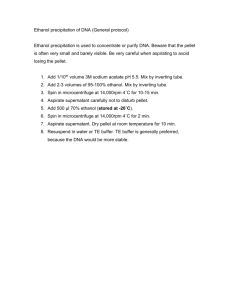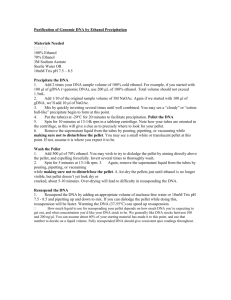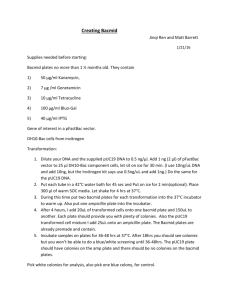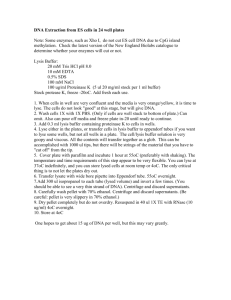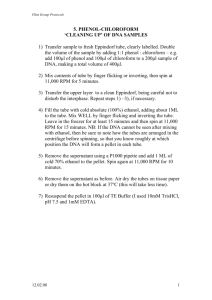DNA Extraction Protocol: Ammonium Acetate Precipitation
advertisement
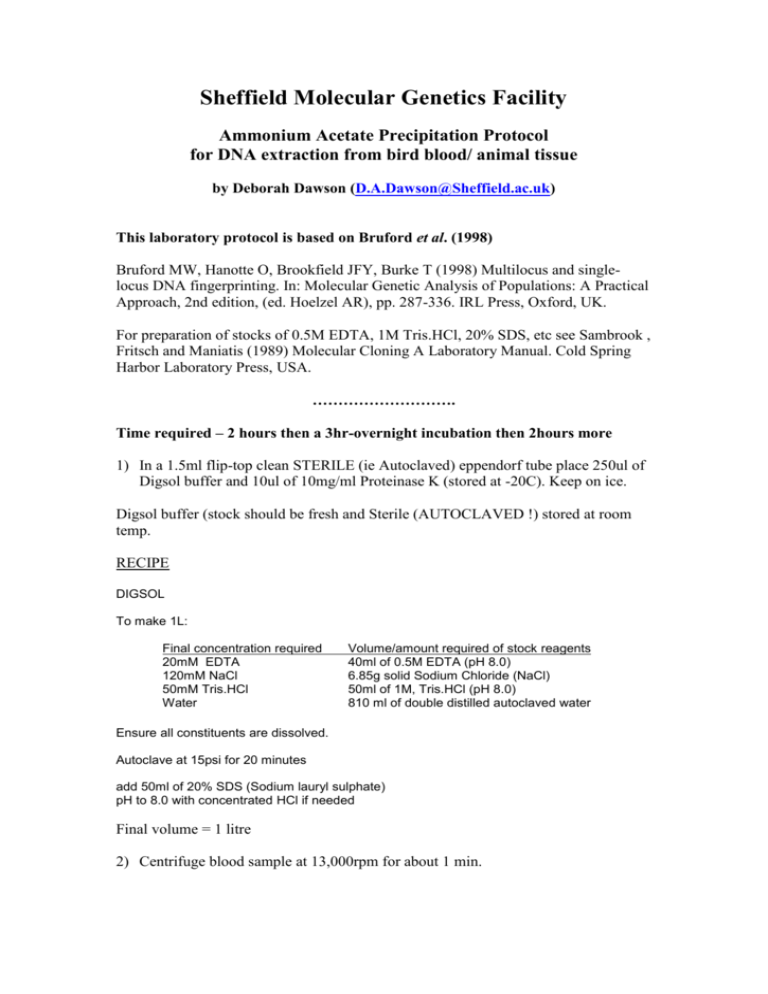
Sheffield Molecular Genetics Facility Ammonium Acetate Precipitation Protocol for DNA extraction from bird blood/ animal tissue by Deborah Dawson (D.A.Dawson@Sheffield.ac.uk) This laboratory protocol is based on Bruford et al. (1998) Bruford MW, Hanotte O, Brookfield JFY, Burke T (1998) Multilocus and singlelocus DNA fingerprinting. In: Molecular Genetic Analysis of Populations: A Practical Approach, 2nd edition, (ed. Hoelzel AR), pp. 287-336. IRL Press, Oxford, UK. For preparation of stocks of 0.5M EDTA, 1M Tris.HCl, 20% SDS, etc see Sambrook , Fritsch and Maniatis (1989) Molecular Cloning A Laboratory Manual. Cold Spring Harbor Laboratory Press, USA. ………………………. Time required – 2 hours then a 3hr-overnight incubation then 2hours more 1) In a 1.5ml flip-top clean STERILE (ie Autoclaved) eppendorf tube place 250ul of Digsol buffer and 10ul of 10mg/ml Proteinase K (stored at -20C). Keep on ice. Digsol buffer (stock should be fresh and Sterile (AUTOCLAVED !) stored at room temp. RECIPE DIGSOL To make 1L: Final concentration required 20mM EDTA 120mM NaCl 50mM Tris.HCl Water Volume/amount required of stock reagents 40ml of 0.5M EDTA (pH 8.0) 6.85g solid Sodium Chloride (NaCl) 50ml of 1M, Tris.HCl (pH 8.0) 810 ml of double distilled autoclaved water Ensure all constituents are dissolved. Autoclave at 15psi for 20 minutes add 50ml of 20% SDS (Sodium lauryl sulphate) pH to 8.0 with concentrated HCl if needed Final volume = 1 litre 2) Centrifuge blood sample at 13,000rpm for about 1 min. 3) Remove a blob of blood (or liver tissue) from the ethanol in which it is stored with a STERILE (autoclaved) toothpick and blot onto clean tissue. When the blood on the toothpick is blotted dry, place it the eppendorf containing the Digsol buffer and jiggle the toothpick to dislodge the blood. When the blood has fallen into the Digsol buffer, remove toothpick and discard by placing in bleach. 4) Vortex for 30 seconds, wrap the rack in tissue and cling-film and place in rotating oven at 55 (3hrs) or 37 degrees centigrade overnight. 5) Once digested (when digested the solution becomes a straw colour) add 300ul 4M ammonium acetate to each eppendorf. 6) Vortex for 30 seconds several times over a period of at least 15 minutes at room temp. 7) Centrifuge for 15 minutes at 15,000rpm (15 mins and 13,000-15, 000 rpm are needed to ensure the DNA is spun to the bottom of the eppendorf – this is based on the size of DNA – Ensure your centrifuge it set to 13,000rpm or is manufacturer to reach this speed. 8) Transfer supernatant (clear liquid) into clean sterile (autoclaved) labelled 1.5ml eppendorf by using a P1000 pipette (discard the original eppendorf which now contains only the gunky protein stuff). 9) Add 1ml 100% ethanol to your supernatant using a P1000 pipette. 10) Vortex 2 seconds and then invert eppendorf gently 10-20 times to precipitate DNA – DNA may be seen as white spiral threads if it is concentrated or a cloudy white precipitant but don’t worry if no change is observed. 11) Centrifuge for 15 minutes at 15,000rpm 12) Pour and the pipette off ethanol taking care not to lose DNA pellet – the pellet is your DNA ! – Ensure all ethanol is removed using a P200 pipette (otherwise future PCRs and restriction digests will be inhibited.) 13) Add 900ul 70% cold ethanol (stored at –20C) and invert gently 10-20 times to rinse pellet (removes the salt which also inhibits future reactions). 14) Pour and the pipette off ethanol taking care not to lose DNA pellet – the pellet is your DNA ! – Ensure all ethanol is removed using a P200 pipette (otherwise future PCRs and restriction digests will be inhibited.) 15) If the pellet dislodges from the bottom of the tube centrifuge for 5 minutes at 15,000rpm to fix it back to the bottom of eppendorf. 16) Perform a second -70C rinse. Add 900ul 70% cold ethanol (stored at –20C) and invert gently 10-20 times to rinse pellet (removes the salt which also inhibits future reactions). 17) Pour and the pipette off ethanol taking care not to lose DNA pellet – the pellet is your DNA ! – Ensure all ethanol is removed using a P200 pipette (otherwise future PCRs and restriction digests will be inhibited.) 18) If the pellet dislodges from the bottom of the tube centrifuge for 5 minutes at 15,000rpm to fix it back to the bottom of eppendorf. 19) Pour off ethanol and stand eppendorfs open underneath a desk lamp for 30 minutes to dry the pellet. Pellet appears as a white flake of skin when dry as opposed to a translucent piece of gel when wet. It must be dry before proceeding. 20) Once fully dry add 100ul -300ul T10 E0.1. or sterile (double distilled) autoclaved water to resuspend the pellet. Add 100ulif a small amount of blood was used and a small pellet observed Add 300ul is a big amount of blood was used and a large pellet observed NOTE. It is essential the TE is freshly made and has been AUTOCLAVED so is Sterile ! TE (Stock should be fresh and Sterile (AUTOCLAVED !). Stored at room temp) RECIPE Low TE (TE10E0.1) ( pH 7.5-8.0) Concentration required 10mM Tris.HCl 0.1mM EDTA Water for making up 400ml Volume of stock reagents required 4ml of 1M Tris.Hcl (pH 8.0) 80ul (NB MICROLITRES!) of 0.5M EDTA (pH 8.0) 396ml of double distilled autoclaved water Final Volume = 400ml No necessary to pH Autoclave 15psi for 20 mins 21) Briefly vortex (2 second blasts) and flick sample 5-10 times to dislodge pellet 22) Place eppendorfs in waterbath for 30 minutes (37 or 65 degrees) to dissolve pellet (flicking every 10 mins) 23) Ensure pellet is suspended using a P1000 pipette to mix the DNA and TE – it is essential the DNA is fully dissolved. If the DNA solution is still glupey – it is highly concentrated – This can be checked on a 0.8% agarose check and 100ul more sterile TE added. 24) Store at –20C degrees. Stored at –20 to prevent DNAases from digesting and degrading the DNA. (DNAases are present on your skin and any non-sterile solutions and would if present digest all the DNA in your eppendorf – leading you to loosing the whole extracted DNA sample). Can be kept at 4 degrees during the day for a maximum of 1 day. DNAases can be active at 4C so storing for longer than one day not recommended. Best to return to 20C freezer each time after use. Other DNA extraction methods are commonly used using phenol/chloroform (see Mantias and Sambrook, Chelex resin and prepared kits. -X-
